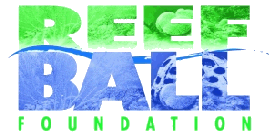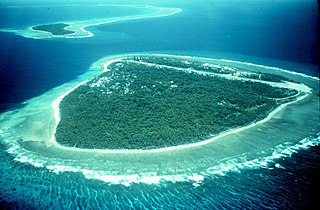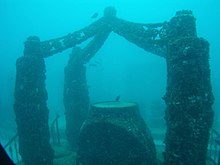
Burial, also known as interment or inhumation, is a method of final disposition whereby a dead body is placed into the ground, sometimes with objects. This is usually accomplished by excavating a pit or trench, placing the deceased and objects in it, and covering it over. A funeral is a ceremony that accompanies the final disposition. Evidence suggests that some archaic and early modern humans buried their dead. Burial is often seen as indicating respect for the dead. It has been used to prevent the odor of decay, to give family members closure and prevent them from witnessing the decomposition of their loved ones, and in many cultures it has been seen as a necessary step for the deceased to enter the afterlife or to give back to the cycle of life.

A reef is a ridge or shoal of rock, coral or similar relatively stable material, lying beneath the surface of a natural body of water. Many reefs result from natural, abiotic (non-living) processes such as deposition of sand or wave erosion planing down rock outcrops. However, reefs such as the coral reefs of tropical waters are formed by biotic (living) processes, dominated by corals and coralline algae. Artificial reefs such as shipwrecks and other man-made underwater structures may occur intentionally or as the result of an accident, and are sometimes designed to increase the physical complexity of featureless sand bottoms to attract a more diverse range of organisms. Reefs are often quite near to the surface, but not all definitions require this.

Burial at sea is the disposal of human remains in the ocean, normally from a ship, boat or aircraft. It is regularly performed by navies, and is done by private citizens in many countries.
An artificial reef (AR) is a human-created freshwater or marine benthic structure. Typically built in areas with a generally featureless bottom to promote marine life, it may be intended to control erosion, protect coastal areas, block ship passage, block the use of trawling nets, support reef restoration, improve aquaculture, or enhance scuba diving and surfing. Early artificial reefs were built by the Persians and the Romans.

The New England Aquarium is a nonprofit organization located in Boston, Massachusetts. The species exhibited include harbor and northern fur seals, California sea lions, African and southern rockhopper penguins, giant Pacific octopuses, weedy seadragons, and thousands of saltwater and freshwater fishes. In addition to the main aquarium building, attractions at Central Wharf include the Simons Theatre and the New England Aquarium Whale Watch. More than 1.3 million guests visited the aquarium each year prior to the outbreak of the COVID-19 pandemic.

Natural burial is the interment of the body of a dead person in the soil in a manner that does not inhibit decomposition but allows the body to be naturally recycled. It is an alternative to typical contemporary Western burial methods and modern funerary customs.

Diadema antillarum, also known as the lime urchin, black sea urchin, or the long-spined sea urchin, is a species of sea urchin in the family Diadematidae.

The Neptune Memorial Reef is an underwater columbarium in what was conceived by the creator as the world's largest man-made reef at a depth of 40 feet (12 m) ). It was originally conceived by Gary Levine and designed by artist Kim Brandell and known as the Atlantis Reef Project or the Atlantis Reef As of 2012, the Reef occupies a one-half-acre (0.20 ha) space, but a planned expansion 16 acres (6.5 ha) is underway. The city design involves underwater roads leading to a central feature with benches and statuary.

Reef Ball Foundation, Inc. is a 501(c)(3) non-profit organization that functions as an international environmental non-governmental organization. The foundation uses reef ball artificial reef technology, combined with coral propagation, transplant technology, public education, and community training to build, restore and protect coral reefs. The foundation has established "reef ball reefs" in 59 countries. Over 550,000 reef balls have been deployed in more than 4,000 projects.

The Cancún Underwater Museum is a non-profit organization based in Cancún, Mexico devoted to the art of conservation. The museum has a total of 500 sculptures, by a series of international and local sculptors, with three different galleries submerged between three and six meters deep in the ocean at the Cancún National Marine Park. The museum was thought up by Marine Park Director Jaime González Cano, with the objective of saving the nearby coral reefs by providing an alternative destination for divers. It was started in 2009 and officially opened in November 2010.

Human activities have substantial impact on coral reefs, contributing to their worldwide decline.[1] Damaging activities encompass coral mining, pollution, overfishing, blast fishing, as well as the excavation of canals and access points to islands and bays. Additional threats comprise disease, destructive fishing practices, and the warming of oceans.[2] Furthermore, the ocean's function as a carbon dioxide sink, alterations in the atmosphere, ultraviolet light, ocean acidification, viral infections, the repercussions of dust storms transporting agents to distant reefs, pollutants, and algal blooms represent some of the factors exerting influence on coral reefs. Importantly, the jeopardy faced by coral reefs extends far beyond coastal regions. The ramifications of climate change, notably global warming, induce an elevation in ocean temperatures that triggers coral bleaching—a potentially lethal phenomenon for coral ecosystems.
Jason deCaires Taylor is a British sculptor and creator of the world's first underwater sculpture park – the Molinere Underwater Sculpture Park – and underwater museum – Cancún Underwater Museum (MUSA). He is best known for installing site-specific underwater sculptures that develop naturally into artificial coral reefs, which local communities and marine life depend on. Taylor integrates his skills as a sculptor, marine conservationist, underwater photographer and scuba diving instructor into each of his projects. By using a fusion of Land Art traditions and subtly integrating aspects of street art, Taylor produces dynamic sculptural works that are installed on the ocean floor to encourage marine life, to promote ocean conservation and to highlight the current climate crisis.

The Molinere Bay Underwater Sculpture Park is a collection of ecological underwater contemporary art located in the Caribbean sea off the west coast of Grenada, West Indies and was created by British sculptor Jason deCaires Taylor. In May 2006 the world's first underwater sculpture park was open for public viewing. Taylor's aim was to engage local people with the underwater environment that surrounds them using his works which are derived from life casts of the local community. He installed concrete figures onto the ocean floor, mostly consisting of a range of human forms, from solitary individuals to a ring of children holding hands, facing into the oceanic currents.

The Oracabessa Bay Fish Sanctuary was established in 2010 to protect Oracabessa’s marine ecosystem. Its mission is to increase biodiversity in Oracabessa Bay to improve livelihoods in the local community. Through investments by the Oracabessa Foundation, Seacology, and GEF, the Fish Sanctuary has reintroduced Sea turtles and thousands of new coral into the Oracabessa Bay area. There are several reefs located in the Oracabessa Bay Fish Sanctuary as well as mangroves and beaches including James Bond Beach. The Golden Clouds reef is one of the largest in Oracabessa Bay and is a popular dive destination due to its diverse reef structure, vibrant marine life and close proximity to the Cayman Trough.

The Neptune Society, Inc. is an American provider of cremation services that was founded in Plantation, Florida.
Sisters’ Islands Marine Park is a 400,000 square metre(40ha) marine park located in Southern Islands planning area, Singapore, which was designated a marine protected area (MPA) by the Government of Maritime and Port Authority of Singapore in 2014. The park encompasses the land and waters surrounding Sisters' Islands, and also covers the western coasts of both St John's Island and Pulau Tekukor.

The Great Southern Reef is a system of interconnected reefs that spans the southern coast of continental Australia and Tasmania and extends as far north as Brisbane to the east and Kalbarri to the west. It covers 71,000 km2 (27,000 sq mi) of ocean and straddles five states, running along the coast for 8,000 km (5,000 mi).

Maiden Island, also known as "Maid Island" or "Maiden Islet," is a small private island which is part of the independent nation of Antigua and Barbuda.

An electric reef is an artificial reef made from biorock, being limestone that forms rapidly in seawater on a metal structure from dissolved minerals in the presence of a small electric current. The first reefs of this type were created by Wolf Hilbertz and Thomas J. Goreau in the 1980s. By 2011 there were examples in over 20 countries.
Shimrit Perkol-Finkel was an Israeli marine biologist. She researched artificial coral reefs and developed ecological concrete products, green construction and CleanTech. She was a co-founder of two companies in the field of marine ecology, and also served as the CEO of one of them, "ECOncrete". Perkol-Finkel authored over 20 scientific articles. Her work was awarded prizes by the United Nations and the European Union. In 2019 she was chosen by "Forbes" as one of the top 50 women-led Startups that are crushing tech. In the same year, the patent she developed, together with her partner Ido Sella, was chosen as one of the 100 best inventions in the world by Time magazine.

















